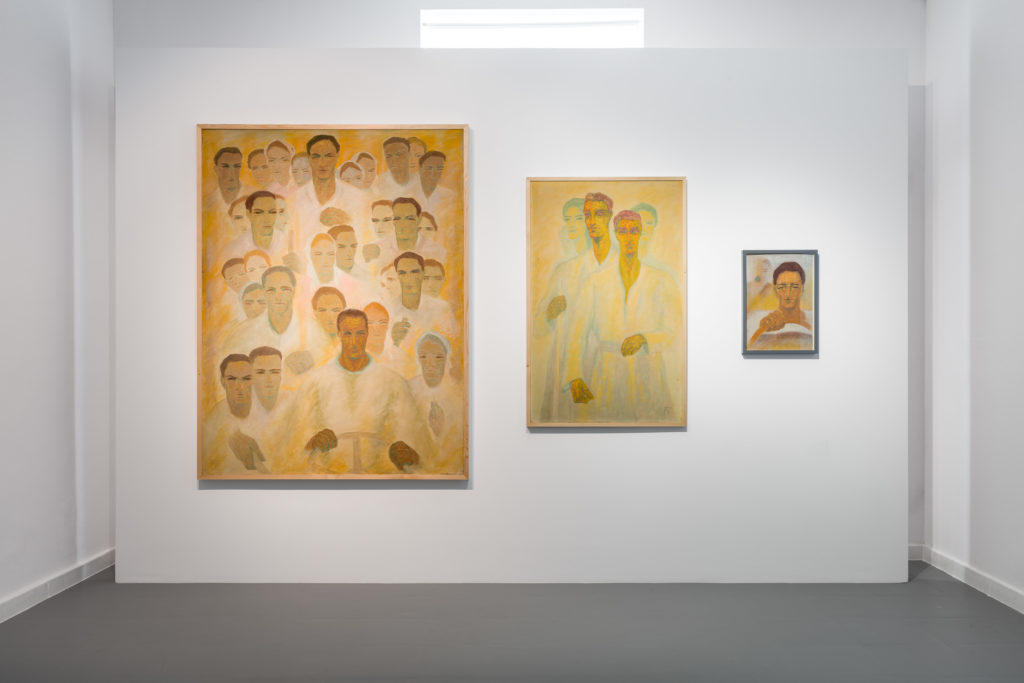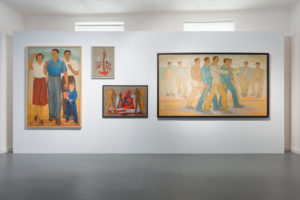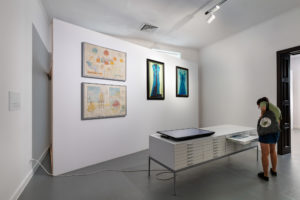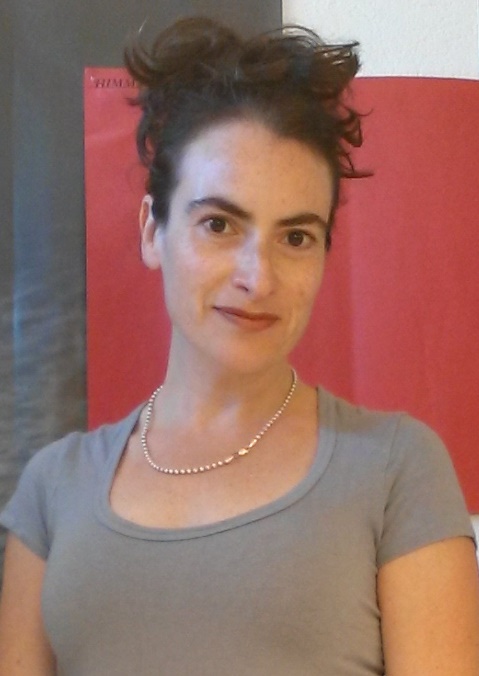Mattis Teutsch: Avant-Garde and Constructive Realism
Mattis Teutsch: Avant-Garde and Constructive Realism, Scena9, Bucharest, September 12, 2019 – October 25, 2019
János Mattis Teutsch, the Hungarian-German-Romanian painter from Brașov, was characterised in 1920 as “the first who has the audacity to present to the Romanian public works in an expressionist style.” (Sigmund Maur, Rampa newspaper, October 21, 1920.) Mattis Teutsch was associated with the likes of Kandinsky, Marc, and Klee both in actual exhibitions, and in discussions of his artistic and conceptual calibre. His legacy today, however, is something of a battlefield, and the explanation for this lies in the seemingly incongruent bodies of work that the artist created before and after the rise of Nazism.
A talented colorist and abstractionist, Mattis Teutsch established his reputation in the last years of the first decade of the 20th century in Germany and Hungary during a time when various forms of modern art were articulating themselves in Europe. Theories on the role of art in societal transformation were also competing for dominance. Expressionism, for example—while abandoning clear references to form, although maintaining it as source material in its experiments with transmission of sensation and emotion—was defined by the Romanian artist and art critic Sigmund Maur as “believing in a world of the spirit.” Maur likewise described Mattis Teutsch’s paintings, in his first solo show in Bucharest in 1920, as embodying “the laws of the spirit not those of the natural order.”(Ibid.) Being a native speaker of all three languages, Mattis Teutsch had no difficulty integrating himself in the avant-garde circles of Germany, Hungary, and Romania, and facilitating artistic exchanges among cultural producers from the three countries. His work of these early years appeared in Der Sturm, Contimporanul (a Romanian avant-garde newspaper), and left-wing Hungarian publications like Ma. After many group and solo shows throughout Europe (primarily in the countries mentioned), and after a short stint contributing to Contimporanul from Paris, Mattis Teutsch moved back to Brașov, where he settled permanently. From there, on the margins of Europe, he witnesses in despair the rise of global and local fascism and Nazism.

From left to right: Janos Mattis Teutsch, Peasants (Tractor Driver) 1957. Casein-tempera on canvas, 136×180 cm. Collection of the Mattis Teutsch Family; Peasants, 1957. Casein-tempera on plywood, 80×125 cm. Collection of the Mattis Teutsch Family; and The Driver, 1956. Casein-tempera on paper, 50×35 cm. Brașov Art Museum (nr.inv. 1867). Image courtesy of Scena9.
In the 1930s, after supporters of the Iron Guard (a Romanian fascist group) took over the institutions of Brașov, he was expelled from the local art group for not showing enough enthusiasm toward this reactionary, anti-semitic, ultra-nationalist, and anti-European vision of world order. Mattis Teutsch did not actively engage in antifascist activity, nor did he produce antifascist art, as did some of his more politically engaged avant-garde colleagues (such as M.H. Maxy, Jules Perahim, Aurel Marculescu, and several others). Instead, he chose to retreat from all public and artistic activity. This form of resistance cannot be considered courageous, especially in contrast to artists like Marculescu, who openly expressed his antifascist beliefs through art and activism, paying the price with incarceration and later deportation. However, Mattis Teutsch’s passive rejection was nevertheless deemed adequate even by Scînteia, the official newspaper of the Communist Party , which contrasted this approach to that of those who continued their artistic activity during Romania´s fascist period.(L.S., “About Some Art Monographs,” Scînteia, November 26, 1944.) A 1944 article contrasted “the retreat to the easel” of some to the actions of other artists (such as Milița Pătrașcu, Oscar Han, etc.) who went so far as to exhibit in official salons under Marshall Antonescu’s fascist dictatorship and continued successful careers also under the new Communist regime.
In the early 1940s—while the war was still raging and after suffering extreme personal tragedy with the loss of his daughter—Mattis Teutsch began working again, privately. This second body of work moves away from the Expressionist abstractions of his avant-garde period (such as the Soul Flowers series) into figurative experiments with idealized and archetypal forms of the ‘New Man,’ a project that he first articulated in his 1931 treatise, Kunstideologie (Ideology of Art). In a later text,(János Mattis Teutsch, Thoughts about the Creative Work of the Artist in the Socialist Era (1959).) he used the term “constructive realism” to refer to his work—a form of Socialist Realism that, although also dedicated to the social function of art, maintained the individuality and autonomy of the artist.
Despite a flurry of artistic activity and even high-ranking positions in the new ideologically fuelled artist groups of Brașov during the first years of the communist era, starting in the early 1950s Mattis Teutsch was once again ostracized from official art circles. His unconventional aesthetics and preoccupation with spirituality, in opposition to the dialectical materialism of Marxist-Leninism, no longer reflected the Socialist Realist dogma that was du jour. Attempts at recuperating his oeuvre began in the late 1960s, after yet another form of official art had established itself. Even then, however, emphasis was placed on Mattis Teutsch’s avant-garde period, downplaying his later production.
An ambitious and museum-quality exhibition in Bucharest at the Scena9 art space intends to reclaim this second phase of Mattis Teutsch’s oeuvre. Curated by Szilárd Miklós (who is also an artist), Mattis Teutsch: Avant-Garde and Constructive Realism contends that the artistic merit of the artist’s second period is on par with that of the avant-garde period. The value of the avant-garde work is uncontested, cultivated by a strong market, devoted collectors, and even an abundance of forgeries that are coveted as such. However, the latter period has remained tainted by Mattis Teutsch’s unabashed collaboration with and political affinity toward the communist regime in the postwar years, especially since (in the aftermath of the 1989 Revolution) the communist state was recognized as a criminal one.(Presidential Commission for the Analysis of the Communist Dictatorship in Romania, Final Report, prepared by Vladimir Tismăneanu, et al. (Bucharest, 2006).) This evaluation unfortunately also entailed the complete and un-nuanced rejection of the artistic and social achievements of the period, which also encompassed Mattis Teutsch’s second phase. His later paintings never gained the recognition and market support that the curator of the exhibition believes they deserve. Instead, many of the artist’s canvases from the 1940s onwards fell into the hands of commercial galleries, namely MissionArt of Budapest, and were discovered to hide older compositions from the 1930s or earlier. Most were erased by conservators to reveal the original paintings beneath, which command higher prices at auction. This act permanently destroyed the coherence of this second period, mirroring the erasure of cultural production of the socialist years during the post-1990 anti-communist frenzy. A flatfile examining the process of erasure for the sake of profit is included in one of the rooms of the exhibition.
Based on 30 years of research by Hungarian art historian Tibor Almási—whose book The Other Mattis Teutsch fully integrates this second phase in the artist’s oeuvre and creates a complete historiography—the exhibition organized by Miklós features a selection of the artist’s figurative paintings from the 1930s and after, on loan from Mattis Teutsch’s grandson, as well as private and museum collections in Romania. The exhibition includes 32 works spread over 7 rooms, as well as two videos—one of them made by Mr. Miklós in 2019, the other by Hungarian television in the early 2000s. It also features a small reading room showcasing most of the existing literature on Mattis Teutsch. In the lobby of Scena9, a large sinuous wooden construction with a printed chronology on the front illustrates, through its very shape, the turns of history in the artist’s life alongside the course of international events. In front of this structure, on the first wall before entering the exhibition rooms, mounted printouts of the pages of Mattis Teutsch’s book Ideology of Art, are displayed, offering the conceptual foundation of the work that we are about to see.

From left to right: Janos Mattis Teutsch, Stalin’s Birthday, 1949. Casein-tempera on paper, 34×46 cm. Irina Lukász Collection; and Culture (Big version), 1949. Casein-tempera on plywood, 200.2×128 cm. Brașov Art Museum. Image courtesy of Scena9.
Among the first paintings we encounter are two representations of leaders in the Soviet personality cult: one a standard and bland portrait of Lenin (Lenin, 1951) that reveals none of the stylistic specificities of the artist’s other paintings from the period, and another (Stalin’s Birthday, 1949) depicting what can be surmised to be Stalin as a boy with his mother, in a posture alluding to the Madonna and Child, which incorporates the flat planes and color fields that we find in his other works. This painting is placed next to a cold portrait of the artist’s lover and confidante, Irene Lukasz, dressed in a black gown and sitting open-legged holding a book. Irene was an artist in her own right, but also the chronicler of Mattis Teutsch’s life and work in postbellum Romania. It is from her writings that we have information about the artist and his works of this later period. Quotes about Mattis Teutsch taken from her journal appear pasted on the walls of each room, in an attempt to set the tone for the groupings. Her portrait is titled Culture, the word that also appears on the book that she holds with her hand—a direct reference to personifications in ancient Roman statuary, continued in classical painting. The portrait also elaborates the position of the mother in Stalin’s Birthday. Both the Stalin and Lenin portraits were made of the artist’s own initiative, without any official commission or pressure. It remains unclear why Mattis Teutsch engaged in such eulogic representations so late in the Soviet regime, but we can only assume he was still a believer (and of course he wouldn’t have been the only one). While most artists made such official works for a salary or social standing rather than out of conviction, this does not seem to be the case with Mattis Teutsch.(It is worth mentioning that Mattis Teutsch signed a petition to the Romanian government in favor of changing the name of his native city from Brașov to Stalin City in 1950, a change that was ultimately implemented.)

From left to right: Janos Mattis Tuetsch, Family–Festivity, 1954. Casein-tempera on canvas, 119×179 cm. Collection of the Mattis Teutsch Family; Plan for Fresco, c.1931. Tempera on paper, 50×70 cm, Szekler National Museum, Sfântu Gheorghe (nr.inv. A 1125); Plan for Fresco, c.1931. Tempera on paper, 100×70 cm. Szekler National Museum, Sfântu Gheorghe (nr.inv. A 1131); and Mining, 1950. Casein-tempera on canvas, 140×246 cm. Brașov Art Museum (nr.inv. 4570). Image courtesy of Scena9.
The exhibition also traces Mattis Teutsch’s preoccupation with the human figure from the 1930s onward, which some critics suggest is present even in his Soul Flowers of the avant-garde period. To support this claim, they(Author’s audio interview with Szilárd Miklós, December 2019.) point to Mondrian’s method of abstracting form and flattening space until only horizontal and vertical planes remain, similar to the process that Mattis Teutsch adopted. In one grouping of works meaningfully juxtaposed by the curator, 1930s paintings of angular and elongated art deco-style human figures in brown and blue, distributed on the canvas in different patterns (such as two works titled Fresco Plan, 1931), enter into dialogue with post-1940s paintings in which the figure is rendered more realistically, holding tools as symbols of socialist progress (Family – Festivity, 1954, and Mining, 1950). Family – Festivity in particular can be seen as a typically Socialist Realist propaganda painting, lacking any of the characteristics common to most of the work of the artist’s second period. In one of the Fresco Plans, the male figure stands in the exact same position as the men in Mining from 20 years later, both reminiscent of ancient Egyptian representations of humans captured in suspended motion, with one leg in front of the other. Mattis Teutsch regarded the public character of the fresco as superior (and in opposition) to painting, which he viewed as individualist. It is presumably for this reason that Family – Festivity, despite its dogmatic Socialist Realist conventionality, is included alongside the more daring works. Mattis Teutsch explored the fresco and its social function repeatedly throughout his later career, but his endeavors never materialized into an actual public commission; his only public work was a banal monumental statue of the Soviet Soldier.
In another grouping, two paintings from the late 1940s (Scientists, 1946, and Past, Present, Future, 1947) are juxtaposed with two works from the late 1920s. In the center of Past, Present, Future we actually see an easel on which a resting canvas features three figures, a citation of the painting of the late 1920s hung next to it. Additionally, a virile male torso and a female nude (the artist and his muse), a globe of Europe painted in red (representing Socialist victory), two windows representing different seasons, and a bearded male bust alluding to the artist in old age, suggest the convergence of time in the composition. The monochrome background—a shade described as pearl white by one of the inheritors in Miklós’ documentary—flattens the entire space and places all the figures on the same plane, reminiscent of the style of Swiss painter Ferdnand Hodler. Mattis Teutsch’s color palette is reduced here to pastels and earth tones.

From left to right top to bottom: Janos Mattis Teutsch, Scientists 1946. Casein-tempera on canvas, 99×65 cm. Collection of the Mattis Teutsch Family; Past, Present, and Future, 1947. Casein-tempera on canvas, 90×63 cm. Collection of the Mattis Teutsch Family; Two Figures, 1927. Oil on canvas, 57×100 cm. Szekler National Museum, Sfântu Gheorghe (nr.inv. A.795); and Composition, 1927. Oil on canvas, 58×90 cm. Szekler National Museum, Sfântu Gheorghe (nr.inv. A.870). Image courtesy of Scena9.
Another group of paintings from the mid-1950s showcases Matthis Teutsch’s later style, in which the socialist body disappears and is replaced only by an amalgam of busts and faces with large black eyes that cover the entire canvas. They are neither portraits nor completely generic: small differences in features can be detected, but when viewed together they remain an anonymous collective. Some are clearly workers, others are non-specific; all look alien and distant. This later work recalls Self-Portrait with Masks by James Ensor, a Belgian artist who influenced the Surrealists and the Expressionists with whom Mattis Teutsch collaborated. As in the works discussed above, the figures are placed on the same plane, and there is no space in the composition—it is all flat.
Mattis Teutsch’s last solo exhibition during his lifetime was in Bucharest in 1957, organized by M.H. Maxy, his old admirer from the avant-garde years and by then the director of the National Museum of Art. Mattis Teutsch worked tirelessly to produce new work, including the paintings of faces mentioned above, in hopes of a great comeback. Already sickly, he instead experienced extreme disillusionment: the only mention of the show that appeared in the press was a non-enthusiastic and short review in Arta, the official magazine of the union of plastic artists, which doomed him to permanent obscurity. He himself had once lamented that “the times were not appropriate for his painting.”(Tibor Almási, The Other Mattis Teutsch (Győr: Régió Art Publishing House, 2001).) He died in 1960.
What can be said of Mattis Teutsch’s second oeuvre, and—ultimately—of his legacy? Is the work from the 1940s until the 1960s of even greater value than that of the avant-garde, as claimed by the curator in an interview?(The exhibition text contains an interview with the curator of the exhibition, Szilárd Miklós, and his assistant Mircea Nicolae.) What is clear is that it has suffered much destruction from neglect and mishandling, contributing to the uncertainty about Mattis Teutsch’s intentions: a shed in Brașov where the family had stored his work and correspondence was destroyed by workers in the 70s; ruin, loss, and self-interested transactions by some of the inheritors of the Irene Lukasz collection tore apart the cohesion of that collection; there are whispers of museums in Romania selling off original artworks and replacing them with forgeries or nothing at all. Mattis Teutsch’s aesthetic ambiguity inevitably brings to mind numerous other international artists with more clarity of artistic expression. The political intent of his enigmatic depictions—his uncritical preoccupation with spirituality (during the course of his life he was absorbed by theosophy and Rudolf Steiner); antiquated idealization of labor (including art) as the only path to human and personal enlightenment; relentless repetition of symbols, images, and forms; representations of a socialist utopia that had clearly not materialized, without comment or reflection; and a color palette that strikes me as too sweet (bordering on, but not collapsing into, kitsch)—place the merit of his late work and vision on uncertain footing. This oeuvre seems stuck in preoccupations about the past, not responsive to the realities of the society in which he was then living. For these reasons, and despite Mattis Teutsch’s unique style in the artistic milieu of 1940s and 50s Romania, I am personally unconvinced that the artistic value of his second period—which is currently being reclaimed for the sake of art history through exhibitions like Mattis Teutsch: Avant-Garde and Constructive Realism—can be considered as greater than the first, which was indeed innovative and influential. This reclamation concurrently strives to increase the paintings’ market value, which would of course also contribute to efforts to preserve them. Nonetheless, the ominous warning made in 1920 by Sigmund Maur both encapsulates Mattis Teutsch’s fate as an artist and offers a frame for future attempts at evaluating his later work: “Will he know to stop in time? …Attention Mr. Teutsch, the ramp is next to your feet and the abyss is deep.”(Sigmund Maur, Rampa newspaper, October 21, 1920.)
After closing at Scena9, the exhibition is on view at the Lajos Kassák Museum in Budapest until May 3, 2020.





